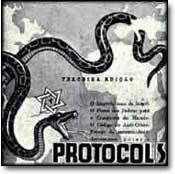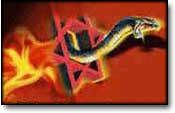Synagugue of Satan
A disagreement over the ownership of a set of Torah rimonim, finial bells, from Colonial times that is worth millions of dollars has led to competing lawsuits between leaders of the nation's first Jewish congregation and the nation's oldest synagogue.
A disagreement over the ownership of a set of Torah finial bells from Colonial times that is worth millions has led to dueling lawsuits between leaders of the nation's first Jewish congregation and the nation's oldest synagogue.
The dispute started after leaders of the nearly 250-year-old Touro Synagogue in Newport, R.I., agreed to sell the bells, called rimonim, for $7.4 million to the Museum of Fine Arts in Boston. The sale is opposed by leaders of Congregation Shearith Israel in New York City, who say it owns Touro and the rimonim.
They argue the sale violates religious practice and will remove ownership of the bells from the Jewish community. They're seeking to remove the Newport congregation from practicing at Touro, which was named a National Historic Site in 1946 and is visited by tens of thousands of people every year.
Both sides have sued in federal court in Rhode Island, and Congregation Shearith Israel has also sued in federal court in New York. U.S. District Judge William Smith in Providence is scheduled to hold a settlement conference Thursday.
Congregation Shearith Israel, which overlooks Central Park on New York City's Upper West Side, was first established in 1654 by Jews of Spanish and Portuguese descent. It is the nation's first and oldest Jewish congregation.
The nation's second Jewish congregation, also of Spanish and Portuguese origin, was established in Newport four years later, drawn by the religious tolerance established in the colony by Rhode Island's founder, Roger Williams. A century later, the Newport congregation bought land and constructed a synagogue, which was dedicated during Hanukkah on Dec. 2, 1763. It was named for Isaac Touro, a Dutch Jew who became the congregation's first spiritual leader.
George Washington visited Newport in 1790, and later that year wrote a now-famous letter to the city's Jewish community affirming the new nation's dedication to religious tolerance, saying it "gives to bigotry no sanction, to persecution no assistance." The letter is now read annually at Touro.
By the early 1800s, the city's Jewish population had dwindled as Newport's importance waned. The city's last Jewish resident left in 1822. In the decades to come, Touro fell into disrepair. Some items, including Torah scrolls and possibly the finial bells, were transferred to the New York congregation.
Touro's leaders claim in its lawsuit that Congregation Shearith Israel became trustee for the Newport synagogue, while Congregation Shearith Israel says it took ownership of the synagogue, its cemetery, Torahs, rimonim and other objects. Touro reopened in the late 1800s, and the Newport congregation ultimately signed a lease in 1903 to rent Touro from Congregation Shearith Israel for $1 per year.
The finial bells were made in the 1760s or 1770s by Colonial silversmith Myer Myers, a Jewish contemporary of Paul Revere's, who operated out of New York. They are placed on the handles of a Torah scroll when not in use. Touro has two of them.
Leaders of Touro in 2010 asked the auction house Christie's to find a buyer for one of its sets, said David Bazarsky, former president of Touro Synagogue and a third-generation member of the congregation there. Their aim was to raise money to ensure Touro will always be maintained, have services and have a rabbi in residence while also finding a place that would allow the public to see the finial bells, he said.
At the time, the MFA was about to open a new Art of the Americas wing, which included a Newport room. The bells have been on display there since 2010, and the museum in 2011 offered to purchase the bells permanently, Bazarsky said.
"Our goal is really to take the money, put it into a trust, and endowment fund, and secure the future while having the opportunity to display the finial bells. We think it's part of history, it's part of the culture of America, and it's overwhelmingly positive," he said.
The MFA's offer has since been rescinded until the ownership dispute is resolved, a spokeswoman for the museum said.
Touro's lawsuit, filed in November, asks Attorney General Peter Kilmartin to intervene because he administers charitable trusts. Spokeswoman Amy Kempe says the office is reviewing the case.
Representatives for Congregation Shearith Israel declined to comment on the record about the lawsuit, but in court papers, they say they learned about the proposed sale in June and had hoped to settle before Touro sued. The New York congregation asks the congregation at Newport be removed from practicing at Touro because, it says, they are violating the terms of the $1-per-year lease. It says Touro is bound to follow its religious traditions, and such a sale violates them.
It suggests a long-term lease of the bells to the museum, something Bazarsky said Touro is open to and has discussed with the MFA but which they can't pursue until they resolve the question of who owns the bells. Still, he said, he is hopeful the two sides can work out an agreement.
What the AP missed is the main point of the entire story.
When the Newport synagogue closed in the early 1800s, it took its Torah scrolls, etc. to Shearith Israel in NYC and locked the doors in Newport, leaving the key with a Quaker family in case the building needed to be accessed in an emergency.
Many years later, acting through Shearith Israel, a group of Ashkenazi Jews who had come to Newport was allowed to rent the building for a minimal sum for use as a synagogue and Hebrew school. The "Turo congregation" today is descended from that group.
It has no legal claims to the original founders, to the original builders or to anything about the historic synagogue other than renting it beginning in approximately 1881. It made an initial show of upholding Sephardic prayer customs and brought in a Sephardic rabbi from London. But by the early 1890s, the Ashkenazim gave up the charade and, essentially, went their own way – even though they had no leagal right to the building or its contents.
The Sephardim who founded Touro came largely from Shearith Israel in NYC and for the most part returned there when Newport's Jewish community failed in the early 19th century. They did not give their expensive building, their artwork and their other possessions to Ashkenazim as a gift – history clearly shows they rented them at a token charge of $1 so that they could retain ownership and ultimate control but allow the building and ritual objects to be used as they were intended to be used, ritually.
Today's Touro leaders – who appear to have a weak grasp of history and halakha – stole the rimonim and tried to sell them.
That's what happened at Touro.
http://failedmessiah.typepad.com/failed_messiahcom/2013/01/when-a-story-fails-to-tell-the-tale-americas-oldest-synagogue-sues-americas-olderst-jewish-congregation-345.html#more
![[9_10_s22.jpg]](https://blogger.googleusercontent.com/img/b/R29vZ2xl/AVvXsEjTXnQay9wzz0E6nVHrVhaHKoq_zYXDqZjijHlNDQzj90MZzInrCuVX4ciFYCiBfZ7lhlgr2bBhhnl7ddWbhdih5JbXjQYbA605TNyiq046bQqjG2A4S-nHTmh1VBTQSG6tmc23wq47QQ/s1600/9_10_s22.jpg)




No comments:
Post a Comment